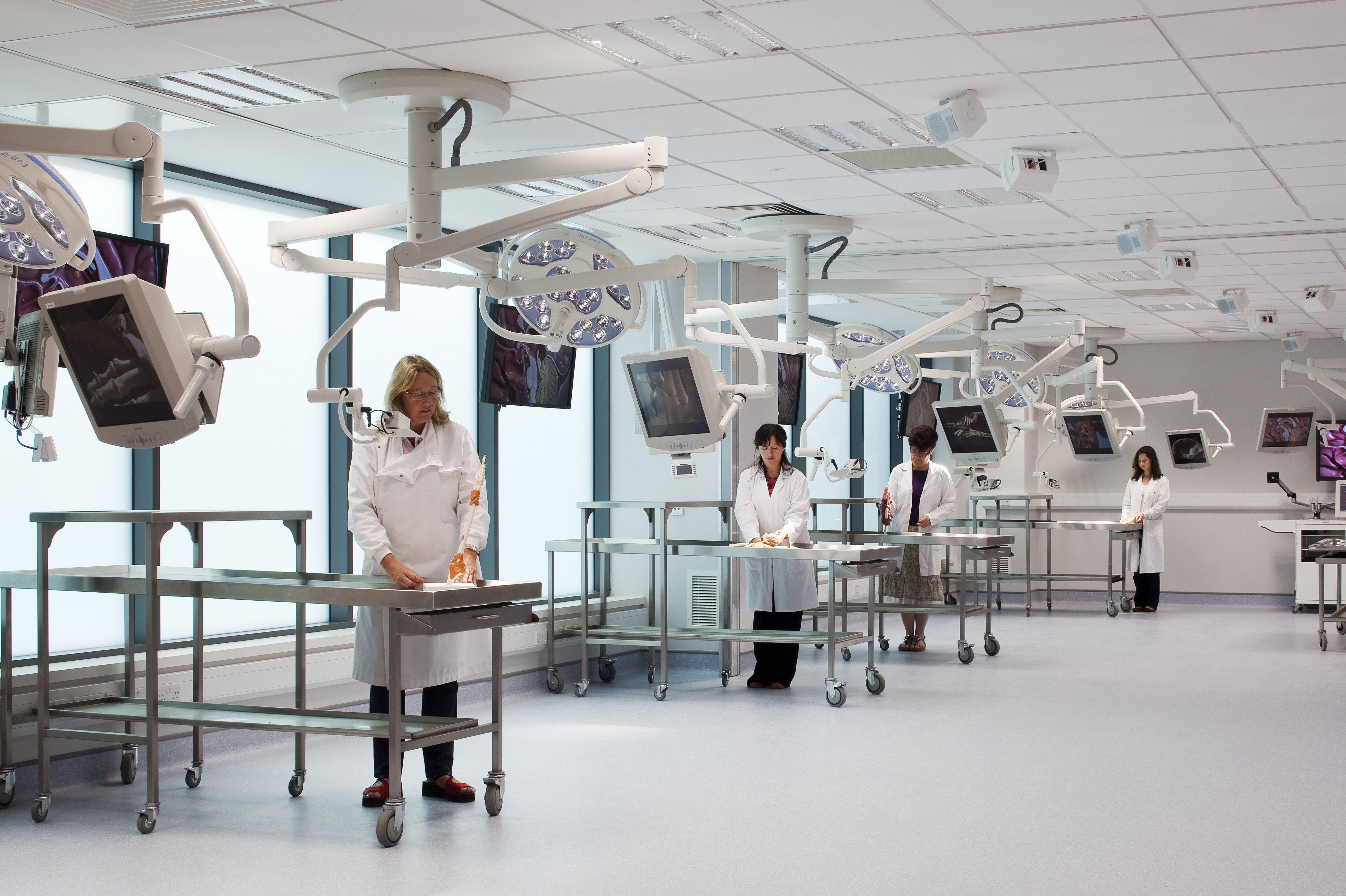
With demand for high-quality AV kit growing in the medical sector, Steve Montgomery assesses the possibilities for professional AV system integrators in the sector and the implications of working in that field.
Contracts for supply of diagnostic machines in medical environments are struck between the specialist providers and the hospital’s (or other establishment’s) in-house radiology department for dedicated and complete systems. Beyond that, there is considerable scope for further system adaptation and customisation by third-parties; areas that are too diverse or of insufficient size and value to interest the main supplier.
“Modality equipment suppliers tend to focus on their specific offering and its application,” explains Alistair Holdoway, managing director of Video South. “There are many areas within the clinical areas in hospitals that require bespoke solutions to suit their areas of specialisation. Doctors may need to combine different assessment technologies in order to understand the complete picture; fluoroscopy and ultrasound for example, and these offer opportunities for integrators who can combine the outputs of separate devices together in the way the physician wants to access them.”
Breaking boundaries
Integrating disparate systems is not as straightforward as would be expected in, say, the corporate AV world, however. Holdoway warns: “Any changes made to a medical system must not impinge on that system: you cannot simply split a video output to an additional screen in a viewing area or control room without considering the reliability and integrity of the original image. Manufacturers like to keep a boundary around their systems and to break into that boundary is difficult; it can be done but requires the trust and confidence of the original equipment installer. There are different signal formats in use across the manufacturers’ products which must be considered. Any device inserted into a signal chain that affects the quality of the original image in any way; by altering its colour or greyscale rendition or geometry, nullifies DICOM compliance and must not be done.”
In addition the medical environment itself presents problems: infection control requires that equipment can be treated with specific disinfectants; installing cabling and ventilated equipment in pressure controlled treatment rooms and operating theatres is often prohibited. The presence of fluids and gases and the need to meet specific safety standards demands that only equipment designed for medical use is used. Control rooms associated with operating theatres are not subject to quite the strict levels of cleanliness but do still have their own higher-than-normal stipulations.
For integrators in this field, it can often be a lengthy process to enter the sector and become recognised. Hospitals do not tend to operate their own specialist AV staff; rather an ‘interested’ doctor or consultant will become involved in the technology and will be a key player in the decision-making process, always looking at it from their perspective.
“Gaining the trust and confidence of hospital staff is a long-term process of relationship building and understanding clinicians’ needs and methodologies,” explains Steve Wood, managing director of Parity Medical. “Each installation is unique; not just in terms of the application meeting the particular specialisation of the clinical team, but the fact that many hospitals are housed in very old buildings with their own architectural peculiarities. Every organisation has their own working practices and there is very little commonality between them. Our experience within the medical sector, and the brand and solution portfolio we have developed over the years, means that we can help a department establish their requirements in their specific setting and suggest and adapt solutions for their consideration based on other, previous installations.”
Room for opportunity
In medical establishments, multidisciplinary team (MDT) rooms provide opportunities for professional AV system integrators at a slightly lower level of complexity. These are areas in which specialists from different clinical areas meet to discuss and review cases and are often extended to fulfil additional roles within a hospital: seminar rooms, videoconferencing suites, live procedure and presentation and lecture theatres. They are outside the strict infection-controlled and diagnostic areas of the establishment and do not require medical-grade, fully DICOM-compliant presentation technology. University hospital training environments also offer additional possibilities for audiovisual integration of medical-class technology.
The equipment required in MDT rooms and training, and the way it is operated, closely resembles that of corporate boardrooms and conference rooms. They do however demand that the highest quality equipment is used: the diagnosis of a medical condition may have already been made but doctors, consultants and nursing staff still need the best possible images on which to review and plan future care.
Projectors and flatpanel displays will usually be specified with DICOM simulation mode. These devices are, as Peter Adams, sales manager medical solutions, NEC explains, “factory calibrated prior to delivery to meet DICOM section 14 based on the measured characteristics of a sample display from a batch; for native gamma curve, brightness, luminance and so on and the corresponding LUT (look-up table) applied to the whole batch – usually of 50 or fewer units. This means that the display performs almost as well as a DICOM-compliant unit. It provides a lower-cost alternative that is demonstrably sufficient for clinical review applications without needing the ability to be individually set and calibrated.”
DICOM simulation displays are not classified as medical devices and should not be used for the medical diagnostic applications of fully DICOM-compliant displays. However the two types share common characteristics that raise them above the level of professional displays. “To achieve the same level of grey shades as a plain X-ray film a diagnostic monitor would need to have at least 450 candela brightness, any less and the image will be clipped and some detail could be missed,” says Rob Musson of Eizo. “The IPEM (Institute of Physicists and Engineering in Medicine) guidelines include tolerance levels and how often a display should be checked, which matches what the UK Medical Physicists would consider right for UK users. AAPM (American Association of Physics in Medicine) guidelines, TG18, set forth visual, quantitative and advanced testing methodologies for both classes of display, including recommendations for ambient lighting which can have a dramatic effect on the visual image presented on a screen. They also offer test cards that assist in establishing whether displays are fully calibrated for medical diagnosis, covering all aspects of a display’s performance: luminance, resolution, noise, glare and even example anatomical images.”
Integration with picture archiving and communications (PACs) systems is also a fundamental requirement in MDT rooms. This is an area that is unlikely to be familiar to general AV integrators, but is certainly not beyond their technical ability. Signal processing, switching and device control are all required, as are encoding for web transmission and videoconferencing and unified communication technologies.
Life cycle
Purchasing contracts normally stipulate that all equipment must have a minimum of five-year life cycle and support guarantee. The design and build programme for a hospital rebuild or renovation can be lengthy and equipment will be expected to last. Substituting any item in a critical medical system is not a viable or quick operation. This is particularly relevant to the graphics cards used in medical imaging systems: rapidly evolving imaging technology and processing power reduces the life cycle of normal graphics cards to as low as six months.
Rob Moodey of Matrox Graphics points out that graphics cards are, “of necessity, extremely high-performance devices. In order to achieve DICOM compliance or simulation they need to have a deep greyscale and colour processing depth and may be required to drive several cloned workstations at once. For precise DICOM calibration, up to 13-bit gamma LUTs are required. Other features such as digital luminance correction, field-of-view correction and image colour profiling greatly simplify integration and setup in third-party imaging applications.”
4K displays are also attractive propositions to the medical imaging industry and likely to be one of the first volume applications for this resolution. Moodey adds: “Cardiologists and other specialists are turning to 4K display to achieve the level of clarity that they desire which puts added demands on the graphic equipment.”
Geert Carrein, vice president of Barco Healthcare, points out the necessity for technical and software support of graphics cards. “The image quality requirements of modern medicine and the necessity to create stations with up to five monitors put considerable demands on the performance of graphics engines,” he says. “We have developed a strategic partnership with AMD for ongoing product support and to allow our modification of the source code to suit specific medical application; leading to features such as the ability to zoom in to large images to show 1:1 part-images.”
As other areas within medical establishments turn to digital display technology for signage, queue control and general information systems, AV integrators are entering the sector to satisfy that demand. There is considerable opportunity to develop the personal relationships that can lead to opportunities in the more medically oriented areas of hospitals and clinical activity. The tools and devices available for them to achieve success are readily available and already within the extensive service portfolio of professional installers. n
www.aapm.org
www.barco.com
www.crestron.eu
www.eizo.com
www.jonesav.net
www.matrox.com
www.nec.com
www.ndssi.com
www.paritymedical.com
www.videosouth.co.uk







